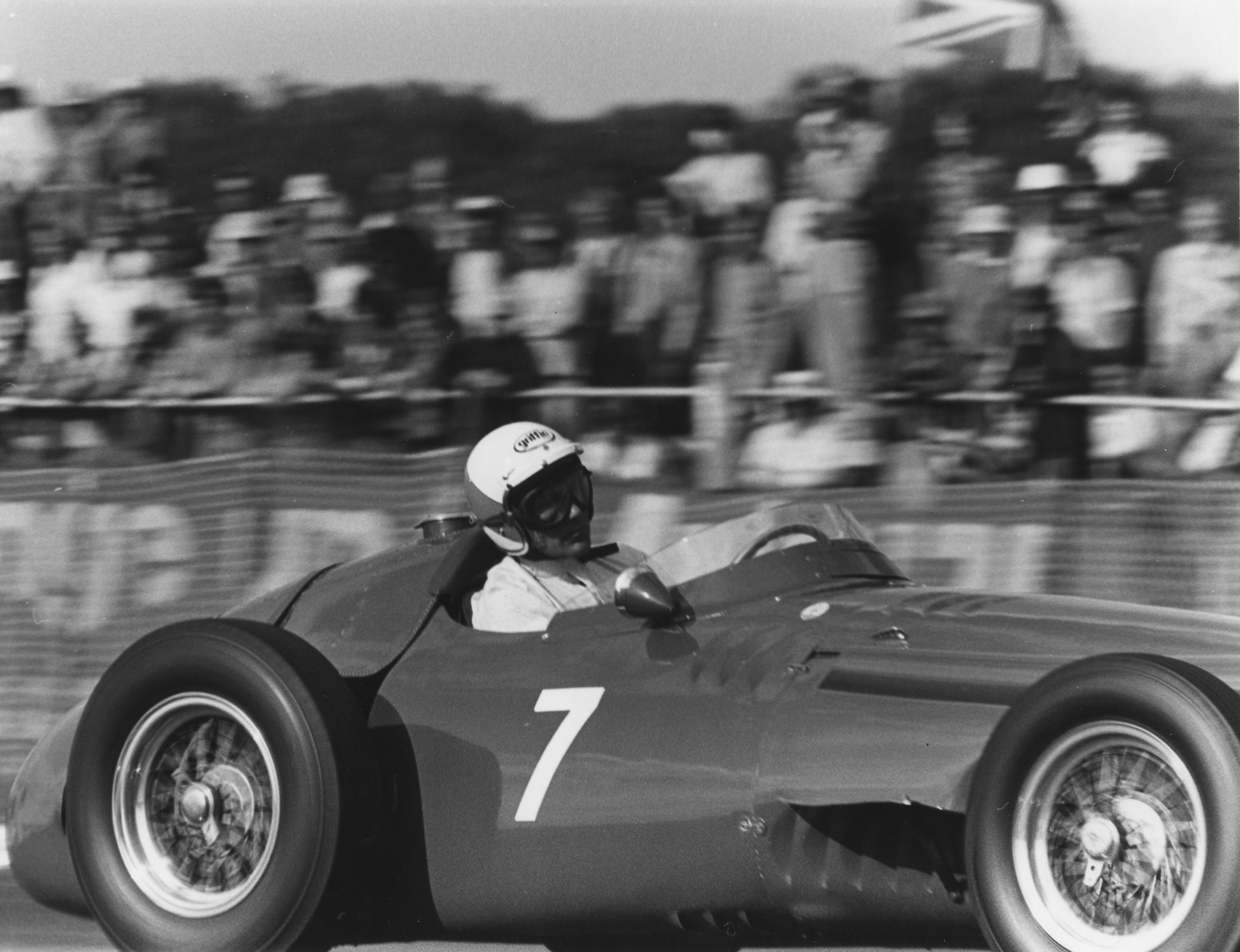
Sir Stirling Moss Obe (1929 – 2020)
12 April 2020It is with great sadness that we have to report the death of one of Great Britain’s finest racing drivers, Sir Stirling Moss OBE, who passed away in the early hours of this morning at the age of 90 after a long illness. In the history of motor racing, not just in his home country but also wherever he raced around the world, Sir Stirling held a unique status which continued throughout his life, long after he retired from his front line racing career following the accident at Goodwood in 1962 in which he sustained serious head injuries. Although he never won the World Drivers’ Championship, Sir Stirling was universally recognised, following the retirement of the great Argentinian Juan Manuel Fangio in 1958, as the racing driver who set the standards by which all other drivers were judged, whether in Formula 1 or international sports car racing. His versatility and competitive instincts made him a formidable competitor in any race even if at times the cars at his disposal were not truly ‘state of the art’, however well prepared they may have been.

The bare statistics of Sir Stirling’s mainstream career are extraordinary. He took part in 585 events, including a few hill climbs and sprints, of which he finished 387 and won 216. Beginning with the 1952 Swiss Grand Prix, he started 66 Drivers’ World Championship races, 16 times from pole position and winning the same number. From 1955 to 1958 he was runner up in the Drivers’ Championship and third in the following three seasons. He lost the 1958 title by a single point to Mike Hawthorn despite winning four races to Mike’s one. Had he not shown his innate sense of fair play by successfully arguing for Mike to be re-instated in second place in the 1958 Portuguese Grand Prix, which Sir Stirling had won, he would have been World Champion. His first World Championship race victory came in the 1955 British Grand Prix at Aintree in the Mercedes-Benz W196 when he just held off team mate Fangio. It will forever be a mystery whether his team leader held back – the weight of evidence suggests not. Two years later at Aintree Sir Stirling, with Tony Brooks, delivered the first victory for a British car – the Vanwall – in a World Championship Formula 1 race.
Sir Stirling was the first to win for both Cooper and Lotus at World Championship level, on both occasions in cars run by Rob Walker’s private team. It was in Rob’s Lotus Type 18 that Sir Stirling produced two of his most virtuosic drives in the 1961 Monaco and German Grands Prix to defeat the significantly more powerful Ferraris.
In sports car racing Sir Stirling was peerless, even when up against Fangio. His victory in the Mercedes-Benz 300SLR in the 1955 Mille Miglia has to be regarded as one of the greatest achievements of all time by a British driver. That year he also won the RAC Tourist Trophy at Dundrod (with John Fitch) and the Targa Florio (with Peter Collins) to secure the World Sports Car Championship for Mercedes. Four years later, he played a major role in securing the same Championship for Aston Martin, his performances in the DBR1/300 in the Nurburgring 1000 Ks and the Tourist Trophy at Goodwood ranking among the finest and most memorable of his stellar career.
Sir Stirling was the last survivor of drivers who had competed in the first ever race at Silverstone, not the RAC International Grand Prix itself but the 500 cc Racing Car race which preceded it on that day in October 1948. Two weeks after his 19th birthday, he led in his Cooper-JAP T5 until being forced to retire with transmission trouble. A month later Sir Stirling was elected to Full Membership of the BRDC, having already won 500 cc races at Brough, Goodwood and Dunholme Lodge. By 1950 he had become a paid professional with the HWM Formula 2 team, racing on the various European road circuits of the day, while continuing to race his Cooper-JAP whenever possible including his first Monaco victories in a heat and the final of the 500 cc Prix de Monte Carlo. Spurned by the British motor racing establishment, who regarded him as driving too fast for his level of experience, no British sports car manufacturer was prepared to offer him a place in its team for the RAC Tourist Trophy in September 1950. The eminent journalist and accomplished racing driver Tommy Wisdom volunteered his Jaguar XK120 to Sir Stirling who drove through a howling gale and torrential rain to totally dominate the race, finishing well ahead of the works Jaguars and the rest. This superb achievement not only silenced the doubters but also ensured that for 1951 Sir Stirling was the lead driver for the Jaguar factory team. His progression to the top of Grand Prix racing at world championship level took a little longer, impeded initially by a fall out with Enzo Ferrari whose peremptory and discourteous treatment of Sir Stirling at the Bari Grand Prix in 1951 resulted in him resolving never to drive for Scuderia Ferrari. In the weeks before the 1962 Goodwood accident a rapprochement seemed imminent but it never came to pass.
The Ferrari episode apart, Sir Stirling wanted to race British Grand Prix cars if at all possible but through 1952 and 1953 such cars were simply no match for the Ferraris and Maseratis. For the new 2.5 litre Formula 1 in 1954 he at last had a car worthy of his ability, a Maserati 250F in which, before the year was out, he had impressed sufficiently to be asked to lead the factory Maserati team and, for 1955, to join Mercedes-Benz and establish himself, with Maserati again in 1956, Vanwall in 1957/58 and Rob Walker’s independent Coopers and Lotus, as one of the greatest racing drivers of all time..
Sir Stirling also achieved notable success in rallies, in particular for the Rootes Group’s Sunbeam team with which he finished second in the 1952 Monte Carlo Rally and won a Coupe d’Or for three successive penalty-free finishes in the arduous Coupe des Alpes. He went record-breaking at Bonneville Salt Flats, Montlhery, Monza and Jabbeke for Austin-Healey, MG, Jaguar, Lotus and Sunbeam.
After retiring from front line racing in 1963, Sir Stirling remained a regular and popular personality both within and outside the world of motor racing. He set up the Stirling Moss Automobile Racing Team ‘SMART’ to run GT and Sports Cars for the likes of Sir John Whitmore and Hugh Dibley and eventually resumed racing himself, mainly in historic events in cars of his era. He also raced an Audi 80 in the British Saloon Car Championship in 1980 and 1981 but found the whole environment rather alien, a 15 lap thrash and bash in a front wheel drive saloon car on slick tyres being a long way removed from a 3 hour Grand Prix at the Nurburgring Nordschleife, Pescara or Monza in a Vanwall or a 250F Maserati. He acquired a number of historic sports cars and it was in one of these, a Porsche RS60 Spyder, of the type with which he and Graham Hill had so nearly won the 1961 Targa Florio, that he decided, while driving down the Mulsanne Straight during practice for the 2011 Le Mans Legends event, that the time had come finally at the age of 81 to hang up his helmet. A year earlier Sir Stirling had sustained some nasty injuries to his ankles and feet from falling down a lift shaft but he remained indefatigable. After contracting a serious chest infection whilst in Singapore in December 2016, Sir Stirling’s recovery was slow and arduous and resulted in his decision in January 2018 to retire from life in the public eye.
Sir Stirling remained a keen and very well-informed observer of the Grand Prix scene and had a particular empathy with Lewis Hamilton MBE. In 2008 the newly-crowned World Champion presented Sir Stirling, on behalf of the BRDC, with the unique honour of Vice-President for Life. Lewis’s words in tribute could not have been more apposite:
Not a day has gone by in the last 60 years when you have not worn the Club badge on either your lapel, tie or overalls. You have been the ultimate ambassador and utterly dedicated and loyal to the BRDC and all that it stands for.’
Sir Stirling was the longest-serving BRDC Member and no one could have been a prouder Member. Between 1950 and 1961 he won 10 much coveted BRDC Gold Stars. Only in 2017 was that record surpassed, fittingly, by Lewis Hamilton MBE.
David Coulthard, President of the British Racing Drivers’ Club (BRDC) commented “Sir Stirling had been a Member of the BRDC since 1948, also the year he competed in the first race meeting held at Silverstone. Since then he has been an extremely loyal Member and a true ambassador for our club. Sir Stirling had a unique and raw talent behind the wheel, loved his racing and lived life to the full. A truly great character and gentlemen who will be sorely missed by all who had the fortune of knowing him. I would like to add my most sincere condolences to Lady Susie Moss, their son Elliot and to his daughter Allison on their loss. Ciao Stirling!”













